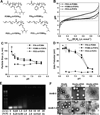Overcoming endosomal barrier by amphotericin B-loaded dual pH-responsive PDMA-b-PDPA micelleplexes for siRNA delivery
- PMID: 22011045
- PMCID: PMC4797624
- DOI: 10.1021/nn203503h
Overcoming endosomal barrier by amphotericin B-loaded dual pH-responsive PDMA-b-PDPA micelleplexes for siRNA delivery
Abstract
The endosomal barrier is a major bottleneck for the effective intracellular delivery of siRNA by nonviral nanocarriers. Here, we report a novel amphotericin B (AmB)-loaded, dual pH-responsive micelleplex platform for siRNA delivery. Micelles were self-assembled from poly(2-(dimethylamino)ethyl methacrylate)-block-poly(2-(diisopropylamino)ethyl methacrylate) (PDMA-b-PDPA) diblock copolymers. At pH 7.4, AmB was loaded into the hydrophobic PDPA core, and siRNA was complexed with a positively charged PDMA shell to form the micelleplexes. After cellular uptake, the PDMA-b-PDPA/siRNA micelleplexes dissociated in early endosomes to release AmB. Live cell imaging studies demonstrated that released AmB significantly increased the ability of siRNA to overcome the endosomal barrier. Transfection studies showed that AmB-loaded micelleplexes resulted in significant increase in luciferase (Luc) knockdown efficiency over the AmB-free control. The enhanced Luc knockdown efficiency was abolished by bafilomycin A1, a vacuolar ATPase inhibitor that inhibits the acidification of the endocytic organelles. These data support the central hypothesis that membrane poration by AmB and increased endosomal swelling and membrane tension by a "proton sponge" polymer provided a synergistic strategy to disrupt endosomes for improved intracellular delivery of siRNA.
© 2011 American Chemical Society
Figures






Similar articles
-
Reversal of lung cancer multidrug resistance by pH-responsive micelleplexes mediating co-delivery of siRNA and paclitaxel.Macromol Biosci. 2014 Jan;14(1):100-9. doi: 10.1002/mabi.201300282. Epub 2013 Aug 21. Macromol Biosci. 2014. PMID: 23966347
-
Triple-Layered pH-Responsive Micelleplexes Loaded with siRNA and Cisplatin Prodrug for NF-Kappa B Targeted Treatment of Metastatic Breast Cancer.Theranostics. 2016 Jan 1;6(1):14-27. doi: 10.7150/thno.13515. eCollection 2016. Theranostics. 2016. PMID: 26722370 Free PMC article.
-
Reversal of doxorubicin resistance in breast cancer by mitochondria-targeted pH-responsive micelles.Acta Biomater. 2015 Mar;14:115-24. doi: 10.1016/j.actbio.2014.12.001. Epub 2014 Dec 9. Acta Biomater. 2015. PMID: 25498306
-
Functional block copolymer assemblies responsive to tumor and intracellular microenvironments for site-specific drug delivery and enhanced imaging performance.Chem Soc Rev. 2013 Sep 7;42(17):7289-325. doi: 10.1039/c3cs60048c. Epub 2013 Apr 3. Chem Soc Rev. 2013. PMID: 23549663 Review.
-
A role for peptides in overcoming endosomal entrapment in siRNA delivery - A focus on melittin.Biotechnol Adv. 2015 Nov 1;33(6 Pt 1):931-40. doi: 10.1016/j.biotechadv.2015.05.005. Epub 2015 May 27. Biotechnol Adv. 2015. PMID: 26025036 Free PMC article. Review.
Cited by
-
MicroRNA-223 Induced Repolarization of Peritoneal Macrophages Using CD44 Targeting Hyaluronic Acid Nanoparticles for Anti-Inflammatory Effects.PLoS One. 2016 May 5;11(5):e0152024. doi: 10.1371/journal.pone.0152024. eCollection 2016. PLoS One. 2016. PMID: 27148749 Free PMC article.
-
Non-Viral Targeted Nucleic Acid Delivery: Apply Sequences for Optimization.Pharmaceutics. 2020 Sep 18;12(9):888. doi: 10.3390/pharmaceutics12090888. Pharmaceutics. 2020. PMID: 32961908 Free PMC article. Review.
-
Synthesis of crosslinkable diblock terpolymers PDPA-b-P(NMS-co-OEG) and preparation of shell-crosslinked pH/redox-dual responsive micelles as smart nanomaterials.RSC Adv. 2019 Oct 29;9(59):34535-34546. doi: 10.1039/c9ra05082e. eCollection 2019 Oct 23. RSC Adv. 2019. PMID: 35529956 Free PMC article.
-
Endosomal Escape of Bioactives Deployed via Nanocarriers: Insights Into the Design of Polymeric Micelles.Pharm Res. 2022 Jun;39(6):1047-1064. doi: 10.1007/s11095-022-03296-w. Epub 2022 May 26. Pharm Res. 2022. PMID: 35619043 Review.
-
Pancreatic Cancer Cell Exosome-Mediated Macrophage Reprogramming and the Role of MicroRNAs 155 and 125b2 Transfection using Nanoparticle Delivery Systems.Sci Rep. 2016 Jul 22;6:30110. doi: 10.1038/srep30110. Sci Rep. 2016. PMID: 27443190 Free PMC article.
References
-
- Elbashir SM, Harborth J, Lendeckel W, Yalcin A, Weber K, Tuschl T. Duplexes of 21-Nucleotide RNAs Mediate RNA Interference in Cultured Mammalian Cells. Nature. 2001;411:494–498. - PubMed
-
- Fire A, Xu S, Montgomery MK, Kostas SA, Driver SE, Mello CC. Potent and Specific Genetic Interference by Double-Stranded RNA in Caenorhabditis Elegans. Nature. 1998;391:806–811. - PubMed
-
- Hannon GJ, Rossi JJ. Unlocking the Potential of the Human Genome with RNA Interference. Nature. 2004;431:371–378. - PubMed
Publication types
MeSH terms
Substances
Grants and funding
LinkOut - more resources
Full Text Sources
Other Literature Sources

